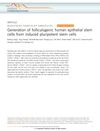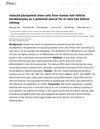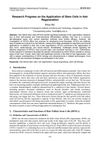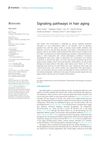TLDR iPSCs can help treat genetic skin disorders by creating healthy skin cells from a small biopsy.
The document discussed the potential of induced pluripotent stem cells (iPSCs) in dermatological research, particularly for treating conditions like hair loss and alopecia. iPSCs, derived from adult cells reprogrammed to an embryonic-like state, offered a promising avenue for generating hair follicles and other skin structures. They could differentiate into various cell types necessary for hair growth and model skin diseases for better understanding and treatment. However, challenges such as ensuring the safety and efficacy of iPSC-derived treatments, including the risk of teratoma formation and potential mutations during cell culture, needed to be addressed before clinical adoption. Despite these challenges, the potential for iPSC technology in developing novel therapies for genetic skin diseases was substantial.
 99 citations
,
January 2014 in “Nature communications”
99 citations
,
January 2014 in “Nature communications” Scientists created stem cells that can grow hair and skin.
64 citations
,
January 2013 in “The journal of investigative dermatology/Journal of investigative dermatology” Human stem cells can help form hair follicles in mice.
 29 citations
,
December 2019 in “Stem Cells Translational Medicine”
29 citations
,
December 2019 in “Stem Cells Translational Medicine” Fully regenerating human hair follicles not yet achieved.
18 citations
,
November 2016 in “PeerJ” Human hair follicles can be used to create stem cells that might help clone hair for treating hair loss or helping burn patients.

Human hair follicle cells can be turned into stem cells that may help clone hair for treating hair loss or burns.
January 2022 in “Stem cell biology and regenerative medicine” iPSCs could help develop treatments for hair loss.
 December 2024 in “Highlights in Science Engineering and Technology”
December 2024 in “Highlights in Science Engineering and Technology” Stem cells show promise for hair regrowth, but challenges remain.
 November 2023 in “Frontiers in cell and developmental biology”
November 2023 in “Frontiers in cell and developmental biology” Hair aging is caused by stress, hormones, inflammation, and DNA damage affecting hair growth and color.




